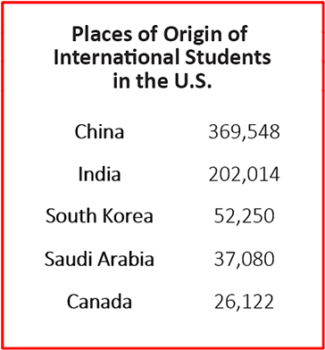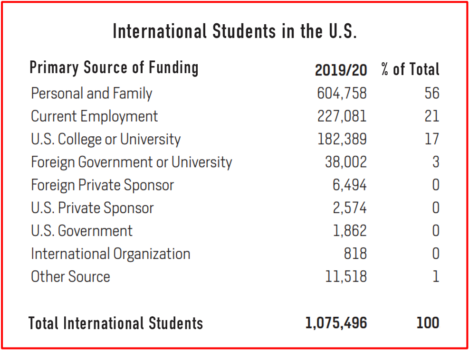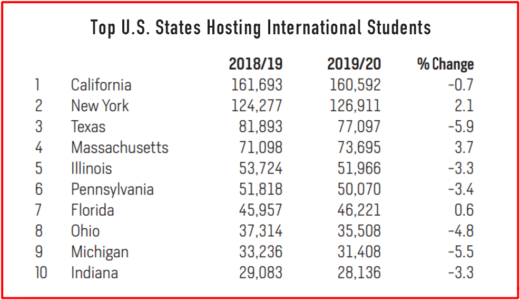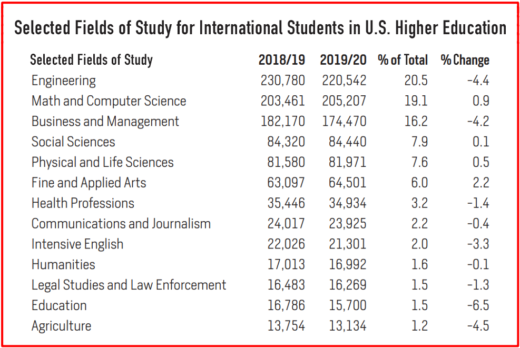 In the past few months, a plethora of reports have documented the impact of the COVID-19 pandemic on global business, and these are generally not something to be happy about. As expected, the international education sector has not been spared. Because of border closures and stringent travel protocols implemented by many countries, international enrollment numbers have plummeted considerably.
In the past few months, a plethora of reports have documented the impact of the COVID-19 pandemic on global business, and these are generally not something to be happy about. As expected, the international education sector has not been spared. Because of border closures and stringent travel protocols implemented by many countries, international enrollment numbers have plummeted considerably.
The recent Open Doors survey of more than 700 colleges and universities in the U.S. conducted by the U.S. State Department’s Bureau of Educational and Cultural Affairs and the Institute of International Education (IIE) reveals that nearly 40,000 international students chose to defer their enrollment during the fall semester. Due to the pandemic-related travel and immigration restrictions, international enrollees often had no choice but to postpone their study plans.
Although most international students who were previously enrolled have signified their intention to continue their studies, the reduced number of new international students entering the country now poses a huge challenge to many institutions. Based on records, the influx of new international students into U.S. schools has plummeted by 43% from the previous year.
International students have had a huge economic impact even amid the pandemic, contributing $38.7 billion to the U.S. economy this year and supporting nearly half a million jobs. The U.S. continues to be a welcoming place for global learners due to the initiatives of higher education institutions (HEIs).
Let’s take a closer look here at the U.S. international student market itself and how HEIs can plan effectively for the future.
The composition
In 2019, among the 5.3 million international students all over the world, more than 1 million or 23% were studying at U.S. colleges and universities.
Based on the data collected by the Institute of International Education (IIE), the countries that send the most students to the U.S. are China, India, South Korea, Saudi Arabia and Canada.

Source: Project Atlas, Institute of International Education
The majority of the top exporting countries in recent years are in Asia, with China as the leading source of international students, followed by India with more than 200,000 students. Students from these two countries combined comprise 50%of the total foreign student enrollment in the U.S.
Factors in choosing a study destination
A survey by the international education analytics firm Quacquarelli Symonds suggests these primary factors that international students are considering when choosing where to study and what field they to pursue:
| Choosing a Course | Choosing a Country | Choosing a University |
| It leads to my chosen career | It is welcoming to international students | It offers scholarships |
| I have a personal interest in the subject | It has universities with high-quality teaching | It is welcoming to international students |
| It is offered by a university with a good reputation | It has an affordable cost of living | It offers high-quality teaching |
| The course offers high-quality teaching | It has a good reputation as a place to study | It offers a specific course I am interested in |
| It has affordable tuition fee options | I can gain work experience in the country after graduating | It has a good reputation for my chosen subject area |
Source: Quacquarelli Symonds
The U.S. has all the assets most regarded by international students and is home to many top universities historically judged to provide high-quality education. Moreover, many recognize that the U.S. is the revered “land of opportunity” which not only provides international students a first-rate education but also opens doors to overseas work experience.
Economic impact of international enrollment
The economic impact of international students is huge, in part because these students pay relatively higher tuition fees. So where do these students get their tuition fee money? What are their sources of funding for expenses? The following table sheds light on those resources.

Source: 2020 Open Doors Survey, Institute of International Education
Apart from the direct monetary value, international students are vital to the competitiveness of the U.S. workforce. According to NAFSA: Association of International Educators, 23% of the billion-dollar companies in the U.S. were founded or co-founded by people who were international students. Hence, these global learners studying and graduating from U.S. academic institutions not only become part of the human resources of the country, but also contributing to job generation that benefits the local population. The presence of international students contributes to the diversity of the student population and global harmony.
International students also help the U.S. maintain its global standing by promoting its foreign policies and international leadership. In fact, 62 current world leaders—including presidents, prime ministers and monarchs—pursued their higher education in the U.S., more than in any other country, according to an analysis by the U.K.-based Higher Education Policy Institute.
Furthermore, foreign students in the U.S. account for many of the world’s renowned scientists and inventors, thus helping in the growth of the country’s knowledge economy. These innovators include Elon Musk, who was born in South Africa in 1971, but went to the U.S. to study at the University of Pennsylvania, where he got bachelor’s degrees in both economics and physics, as well as Subrahmanyan Chandresekhar, a pioneering Indian-American astrophysicist noted for his work on stellar evolution and black holes. Forbes reports that 40% of American Nobel prizes in chemistry, medicine and physics since 2000 were awarded to immigrants.
International students study in almost every state. Some states that house popular universities remain centers for international education. Here are the top 10 states that host the largest number of international students:

Source: 2020 Open Doors Survey, Institute of International Education
Massachusetts is among states that are home to many new immigrants, offering tremendous diversity in world cultures, food and ethnicity. Ethnic enclaves in these and other places help students easily adapt to the area, effectively minimizing the possibility of culture shock.
Many international students begin their academic journey in the U.S. by first studying an intensive English program, then transferring to academic programs upon completing their English studies. The majority of international students enroll in science, technology, engineering and mathematics (STEM) courses. Business programs are also popular. Here are the most popular majors for foreign learners in the U.S.

Source: 2020 Open Doors Survey, Institute of International Education
This piece describes the composition of the U.S. international student market, the courses students pursue,and what attracts them to the education system. Despite the travel ban and the stringent health measures implemented by source countries, foreign student enrollment in U.S. higher education remains strong with more than 1 million students. Much of this was made possible by the fast transition to remote learning among HEIs.
In the coming year, even if we are still dealing with the pandemic, U.S. international enrollment is expected to gradually increase as the availability of the COVID-19 vaccine signals an impending return to some semblance of normalcy. The downturn in trends due to the global health crisis and controversial immigration policies may have shunned some foreign students, but the fact that the U.S. is still viewed by many as the most desirable study destination in the world will remain as the country’s edge in international education. Now is the time for many small- and medium-sized U.S. colleges and universities to weave international enrollment into their future strategic enrollment plans.
Alex Parnia is president of MSM-USA, an international company serving academic institutions in Canada, the U.S., U.K., and the European Union. He was president of Pacific Oaks College & Children’s School from 2012 to 2015. He also served as provost of Nichols College and executive vice president at Cambridge College.
Related Posts:
NEBHE Writes Department of Homeland Security on Nonimmigrant Academic Students, Exchange Visitors
Will Foreign Bodies (and Minds) Continue to Buoy Demographically Challenged New England Higher Ed?
[ssba]
